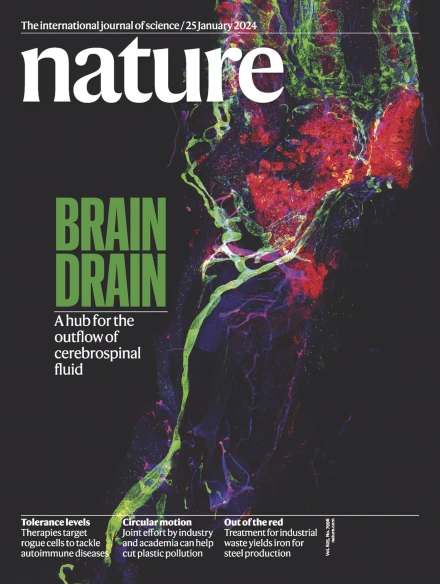Ku限制rna诱导的先天免疫,使alu在灵长类动物中扩增。
IF 48.5
1区 综合性期刊
Q1 MULTIDISCIPLINARY SCIENCES
引用次数: 0
摘要
Ku70和Ku80形成Ku,一个启动非同源末端连接(NHEJ) DNA修复途径的环状复合体Ku结合双链DNA (dsDNA)末端并招募其他NHEJ因子(如LIG4, DNA- pkcs)。虽然Ku可以结合双链RNA (dsRNA)2并在核糖体RNA (rRNA)上捕获突变dna - pkcs,但在其他野生型细胞中Ku-RNA相互作用的生理作用尚不清楚。有趣的是,Ku对小鼠的发育是必不可少的,但对人类细胞却是必不可少的尽管基因组大小相似,但人类细胞比小鼠细胞多表达约100倍的Ku,这意味着功能超出了NHEJ -可能是通过与dsRNA的剂量敏感相互作用,dsRNA与Ku的结合比dsDNA弱10~100倍。2,8研究Ku在人类细胞中的重要性,我们发现,与LIG4不同,Ku耗损通过dsrna传感器MDA5/RIG-I和MAVS诱导深度干扰素(IFN)和NF-kB信号传导。延长的ku降解进一步激活其他dsRNA传感器,特别是PKR(抑制翻译)和OAS/RNaseL(切割rRNA),导致生长停滞和细胞死亡。MAVS、rig - 1或MDA5敲除抑制IFN信号,并且,像PKR敲除一样,都部分地挽救了缺钾的人类细胞。Ku- irclip分析显示Ku与多种dsRNA结合,主要是在内含子和3'- utr中灵长类特异性反义Alu元件的茎环上。Ku表达在高等灵长类动物中急剧上升,与alu扩增密切相关(r = 0.94/0.95)。因此,Ku通过限制dsrna诱导的先天免疫,在灵长类动物中调节alu扩增中起着至关重要的作用,这解释了Ku在人类细胞中的表达升高及其必要性。本文章由计算机程序翻译,如有差异,请以英文原文为准。

Ku limits RNA-induced innate immunity to allow Alu expansion in primates
Ku70 and Ku80 form the Ku heterodimer, a ring-shaped complex that initiates the non-homologous end-joining (NHEJ) DNA repair pathway1. Ku binds to double-stranded DNA ends and recruits other NHEJ factors, including LIG4 and DNA-PKcs. Although Ku can bind to double-stranded RNA (dsRNA)2 and trap mutated DNA-PKcs on ribosomal RNA3,4, the physiological role of the Ku–RNA interaction in otherwise wild-type cells remains unclear. Notably, Ku is dispensable for mouse development5,6 but is essential in human cells7. Despite their similar genome sizes, human cells express about 100-fold more Ku than mouse cells, suggesting that Ku has functions beyond NHEJ, possibly through a dose-sensitive interaction with dsRNA, which binds Ku 10 to 100 times more weakly than double-stranded DNA2,8. Here, Ku depletion induces profound interferon and NF-κB signalling via the dsRNA sensor MDA5–RIG-I and MAVS. Prolonged Ku degradation further activates other dsRNA sensors, especially PKR (also known as EIF2AK2) (suppressing translation) and OAS–RNaseL (cleaving ribosomal RNA), leading to growth arrest and cell death. Knockout of MAVS, RIG-I or MDA5 suppressed interferon signalling and, similarly to PKR knockout, partially rescued Ku-depleted human cells. Ku crosslinking and immunoprecipitation analyses revealed binding of Ku to diverse dsRNA molecules, predominantly stem-loops in primate-specific antisense Alu elements9 in introns and 3′ untranslated regions. Ku expression is higher in primates than in non-primate mammals and is tightly correlated with Alu expansion. Thus, Ku has a vital role in accommodating Alu expansion in primates, limiting dsRNA-induced innate immunity, which explains its high expression and essential function in human cells. Studies on the essentiality of Ku in human cells reveal that Ku interacts with diverse double-stranded RNA molecules, including antisense Alu, and enables tolerance of Alu sequence expansion in primates.
求助全文
通过发布文献求助,成功后即可免费获取论文全文。
去求助
来源期刊

Nature
综合性期刊-综合性期刊
CiteScore
90.00
自引率
1.20%
发文量
3652
审稿时长
3 months
期刊介绍:
Nature is a prestigious international journal that publishes peer-reviewed research in various scientific and technological fields. The selection of articles is based on criteria such as originality, importance, interdisciplinary relevance, timeliness, accessibility, elegance, and surprising conclusions. In addition to showcasing significant scientific advances, Nature delivers rapid, authoritative, insightful news, and interpretation of current and upcoming trends impacting science, scientists, and the broader public. The journal serves a dual purpose: firstly, to promptly share noteworthy scientific advances and foster discussions among scientists, and secondly, to ensure the swift dissemination of scientific results globally, emphasizing their significance for knowledge, culture, and daily life.
 求助内容:
求助内容: 应助结果提醒方式:
应助结果提醒方式:


